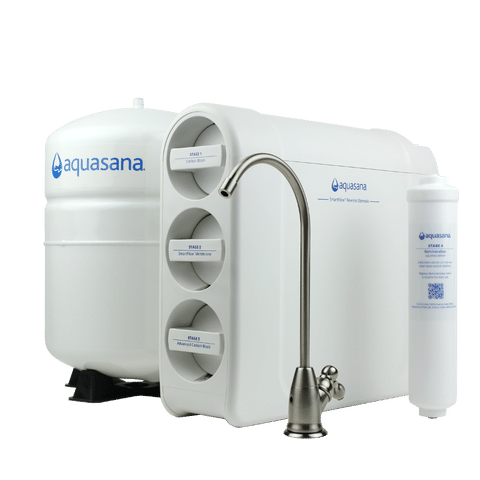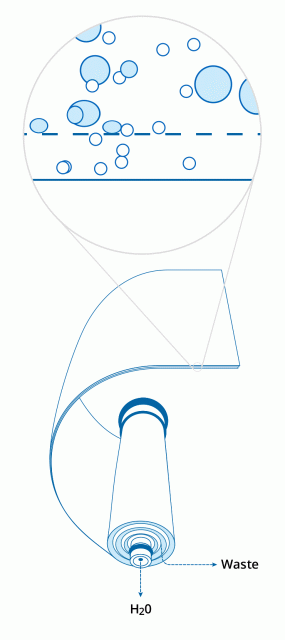What is the difference between reverse osmosis and a regular water filter?
If you’re debating between an RO system and a regular under sink or countertop water filter, there are a few major differences you’ll want to consider:
Contaminant reduction
ROs are the only proven method of water filtration on the market today that removes fluoride. Because fluoride is such a microscopic contaminant, it takes a powerful filtration technology to remove it, which is where the semi-permeable membrane technology comes in. ROs also remove contaminants that most water filters cannot such as arsenic, total dissolved solids (TDS), and nitrate, a tasteless compound that is harmful for babies if ingested. To ensure your RO removes the tougher contaminants, look for a certification for NSF/ANSI Standard 58, which is the contaminant testing standard specifically created for ROs.
Installation
Reverse osmosis systems take a little more time to install and you should be familiar with your under sink plumbing. Unlike direct connect or countertop filters, ROs have permanent fixtures. Most ROs require a dedicated faucet to be installed, which means drilling a small hole in your countertop if you don’t already have one.
Water flow
The purpose of a water tank in an RO setup is to store filtered water so that when you need filtered water, it’s ready. Depending on how much water you use in one use, you may experience low water pressure from the dedicated faucet while the water tank refills. This is because the water tank has been emptied and needs to refill with filtered water. Tank capacities will vary from system to system, so if you have a larger family or plan to fill large water bottles, you may want to consider a system that offers a larger water tank.
Reverse osmosis facts
A few interesting reverse osmosis facts and ways the process is used:
- RO water filters are gaining popularity in the foodservice industry – Many restaurants are investing in RO systems to help improve the taste of their food using the best quality water for cooking.
- Reverse osmosis systems help car washes achieve a “spotless rinse” – Water that hasn’t been filtered can cause scaling and leave spots after a carwash, so some car wash facilities are utilizing RO systems to remove soluble salts that cause these issues so they can provide a “spotless rinse” for customers.
- In the production of maple syrup, RO is used to separate the sugary concentrate from water in the sap.
- The dairy industry uses RO filtration to concentrate whey and milk.
- Wastewater goes through the RO process to create something drinkable, thereby earning the nickname, “toilet to tap” which may be unappealing but provides developing nations with the ability to produce drinkable water.
As stated above, RO is also used to desalinate seawater. In Dubai, where fresh water is limited, large-scale reverse osmosis filters convert about 416 million gallons of seawater to fresh water every day. Dubai’s groundwater supplies only 0.5% of the city’s water – that means the other 99.5% has to come from reverse osmosis. In order to produce 416 million gallons of fresh water, the system has to pump about 2.8 billion gallons of water through it each day.
UNDER SINK WATER FILTER
SmartFlow® Reverse Osmosis
High-efficiency reverse osmosis system removes up to 99.99% of 90 contaminants, including fluoride, arsenic, chlorine, and lead.

Reverse osmosis benefits
Many people wonder if reverse osmosis water is good or bad, but RO filtering has some seriously positive health benefits.
Better tasting water
Reverse osmosis water can improve the taste, odor, and appearance of water. The better your water tastes, the more you'll drink. If you cook with your filtered water, the reverse osmosis filtration can improve the flavor of your food, too.
Helps prevent dementia
A classic example is this study which found that dialysis patients could prevent dementia (a comorbidity that occurred in 18 out of 258 patients) by simply using an RO filter. With no other treatment, scientists were able to improve the condition in 7 out of 9 previously exposed patients and prevent dementia in those whose water was treated from the start of the study.
Helps prevent gastrointestinal illness
Another study tracked the gastrointestinal health of 1400 families and found 14% more gastrointestinal illness in families drinking tap water than in those who were drinking water purified with reverse osmosis. The study noted that “14-40% of gastrointestinal illnesses are attributable to tap water meeting current standards and that the water distribution system appears to be partly responsible for these illnesses.”
To learn more about the benefits of reverse osmosis filtration, check out the pros and cons of reverse osmosis filtration.
How to choose the best reverse osmosis water filter
The best RO filters will have carefully engineered membranes that stand up to daily use. They filter for even the smallest particles and include additional steps to ensure that the water they provide is healthier and safer.
There's a lot of misinformation out there so it's important to understand how many contaminants a RO filter truly removes. Look for certifications from organizations like WQA, NSF, and IAPMO. A reverse osmosis system should pass NSF/ANSI Standards, including Standards 42, 53, 58, and 401. Read more about NSF standards here.
RO systems generally do a good job of stripping out harmful contaminants,, but in the process, many also strip essential minerals that naturally occur in water. There is some disagreement on this issue, with some health experts stating that the amount of minerals in water is negligible anyway, so RO systems are a great option. However, the venerable World Health Organization and many other health experts explain that water is an important source of minerals such as calcium, magnesium, and iron, especially for people in developing countries.
That's why the best water filter system is one that removes harmful contaminants while remineralizing the water. That assures that it not only tastes great but also has the health benefits that essential minerals provide. Unlike other RO systems, Aquasana's SmartFlow® Reverse Osmosis includes a remineralizer to restore beneficial minerals for healthier drinking water. This filter effectively removes 90 harmful contaminants and is WQA tested and certified to meet NSF/ANSI standards 42, 53 (include P473), 58, 401, and CSA B483.1.




